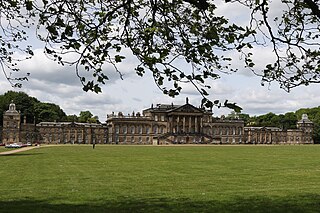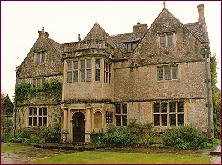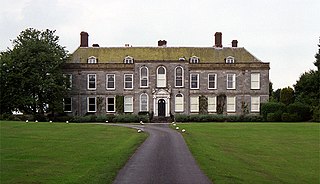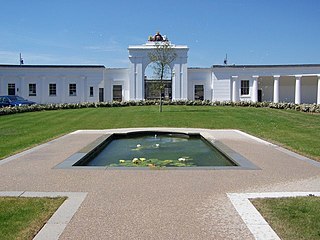
John William Strutt, 3rd Baron Rayleigh, was a British mathematician and physicist who made extensive contributions to science. He spent all of his academic career at the University of Cambridge. Among many honours, he received the 1904 Nobel Prize in Physics "for his investigations of the densities of the most important gases and for his discovery of argon in connection with these studies." He served as president of the Royal Society from 1905 to 1908 and as chancellor of the University of Cambridge from 1908 to 1919.

Gloucester Cathedral, formally the Cathedral Church of St Peter and the Holy and Indivisible Trinity, in Gloucester, England, stands in the north of the city near the River Severn. It originated with the establishment of a minster, Gloucester Abbey, dedicated to Saint Peter and founded by Osric, King of the Hwicce, in around 679. The subsequent history of the church is complex; Osric's foundation came under the control of the Benedictine Order at the beginning of the 11th century and in around 1058, Ealdred, Bishop of Worcester, established a new abbey "a little further from the place where it had stood". The abbey appears not to have been an initial success, by 1072, the number of attendant monks had reduced to two. The present building was begun by Abbott Serlo in about 1089, following a major fire the previous year.

Wentworth Woodhouse is a Grade I listed country house in the village of Wentworth, in the Metropolitan Borough of Rotherham in South Yorkshire, England. It is currently owned by the Wentworth Woodhouse Preservation Trust. The building has more than 300 rooms, although the precise number is unclear, with 250,000 square feet (23,000 m2) of floorspace, including 124,600 square feet (11,580 m2) of living area. It covers an area of more than 2.5 acres (1.0 ha), and is surrounded by a 180-acre (73 ha) park, and an estate of 15,000 acres (6,100 ha).

In the United Kingdom a listed building is a structure of particular architectural and/or historic interest deserving of special protection. Such buildings are placed on one of the four statutory lists maintained by Historic England in England, Historic Environment Scotland in Scotland, Cadw in Wales, and the Northern Ireland Environment Agency in Northern Ireland. The term has also been used in the Republic of Ireland, where buildings are protected under the Planning and Development Act 2000, although the statutory term in Ireland is "protected structure".

The Royal Institution of Great Britain is an organisation for scientific education and research, based in the City of Westminster. It was founded in 1799 by the leading British scientists of the age, including Henry Cavendish and its first president, George Finch. Its foundational principles were diffusing the knowledge of, and facilitating the general introduction of useful mechanical inventions and improvements, as well as enhancing the application of science to the common purposes of life.

Terling is a village and civil parish in the county of Essex, England, between Braintree to the north, Chelmsford to the south-west and Witham to the east.
Baron Rayleigh, of Terling Place in the County of Essex, is a title in the Peerage of the United Kingdom. It was created on 18 July 1821 for Lady Charlotte Strutt, wife of Colonel Joseph Strutt, Member of Parliament for Maldon.

Pembridge is a village and civil parish in Arrow valley in Herefordshire, England. The village is on the A44 road about 6 miles (10 km) east of Kington and 7 miles (11 km) west of Leominster. The civil parish includes the hamlets of Bearwood, Lower Bearwood, Lower Broxwood, Marston, Moorcot and Weston. The 2011 Census recorded the parish population as 1,056.

St Catherine's Court is a manor house in a secluded valley north of Bath, Somerset, England. It is a Grade I listed property. The gardens are Grade II* listed on the Register of Historic Parks and Gardens of special historic interest in England.

St Helen's House is a Grade I listed building. situated in King Street, Derby, England. Now leased as offices, it has been used in the past as a private residence and as an educational establishment.

Robert John Strutt, 4th Baron Rayleigh was a British peer and physicist. He discovered "active nitrogen" and was the first to distinguish the glow of the night sky.
Charlotte Mary Gertrude Strutt, 1st Baroness Rayleigh, known as Lady Charlotte FitzGerald from 1758 to 1789 and as Lady Charlotte Strutt from 1789 to 1821, was a British peeress.
Joseph Holden Strutt, was a British soldier and long-standing Member of Parliament. He served in the Army and achieved the rank of colonel, and also sat as Member of Parliament for Maldon from 1790 to 1826 and for Okehampton from 1826 to 1830.
Sir Nigel Edward Strutt DL TD was the chairman of the Strutt & Parker (Farms) Ltd firm of agricultural property consultants, land agents and farm managers. He farmed 22,500 acres (91 km2) in Essex and Suffolk. He was a Deputy Lieutenant for Essex from 1954, and High Sheriff of Essex in 1966. He was offered of a peerage but declined it, as had his great-great-grandfather, Joseph Holden Strutt.

Hinton Waldrist is a village and civil parish in the Vale of White Horse, England. It was part of Berkshire until the 1974 boundary changes transferred it to Oxfordshire. The village is between Oxford and Faringdon, 9 miles (14 km) southwest of Oxford. The parish includes the hamlet of Duxford. The 2011 Census recorded the parish's population as 328.

John Strutt was a British politician who sat in the House of Commons from 1774 to 1790.
Edward Gerald Strutt CH was a British agriculturist who played an important role in British food and agricultural planning during World War I, for which he received the Order of the Companions of Honour in 1917. Other than this, he ran much of his family's estates, served on government committees and he co-founded the surveyors and land agents Strutt & Parker.

Aldenham Park, also known as Aldenham Hall, is a late 17th-century country house in Morville, near Bridgnorth, Shropshire, England which stands in 12 hectares of parkland. It is a Grade II* listed building.

Royal Clarence Yard in Gosport, Hampshire, England was established in 1828 as one of the Royal Navy's two principal, purpose built, provincial victualling establishments. It was designed by George Ledwell Taylor, Civil Architect to the Navy Board and named after the then Duke of Clarence. The new victualling yard was developed on approximately 20 hectares of land, some of which was already in use as a brewing establishment at Weevil on the west shore of Portsmouth Harbour, to the north of Gosport.
















